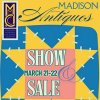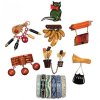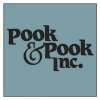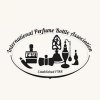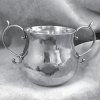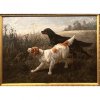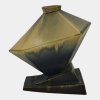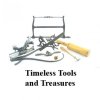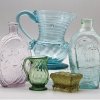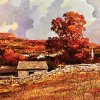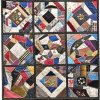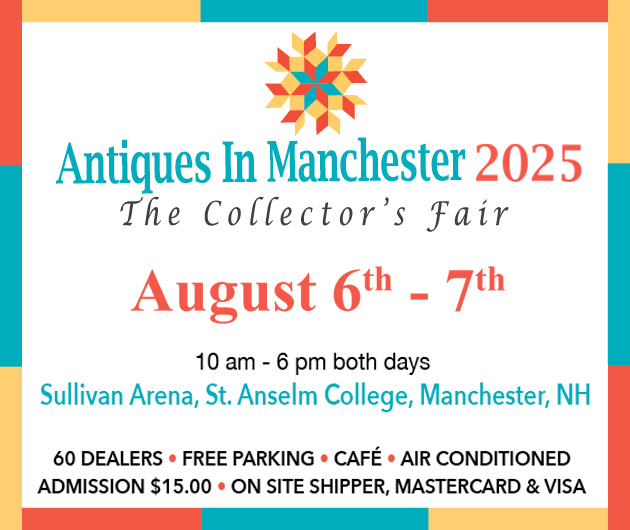Herter Brothers Servers Lead Farmer Auction
April 1st, 2017
Farmer Auctions, Salem, Virginia
Photos courtesy Farmer Auctions
Farmer Auctions, Salem, Virginia, held its spring catalog auction on April 1. This was the first of the firm’s sales that I had attended since it was acquired by Jarrod Hines. Hines purchased the auction business from Will Farmer effective August 1, 2016, and continues to operate under the Farmer name. The catalog notes that Farmer Auctions is an affiliate of Hines Services LLC.
Jarrod Hines comes from an auction family with five generations of experience. As well as the Salem gallery, Hines’s firm operates locations in Radford, Virginia, and Beckley, West Virginia. The companies, trading as Entrusted Auctions, offer a soup-to-nuts auction/sales operation. Business liquidations, real estate, bankruptcies, governmental and institutional surplus, firearms, and estate sales are all on the table. Salon sales, as Hines refers to traditional live gallery auctions, round out the card.
Hines is keenly aware of the ever-changing auction environment and is willing to allow the auction winds to carry him in whichever direction is most effective and efficient for his business and his consignors. His business models include traditional on-site auctions, what he hopes will be regularly scheduled “salon” or gallery catalog sales, and less traditional on-site online auctions.
On-site online sales are an interesting hybrid that is developing. These sales offer a model in which the items being sold are photographed and posted on the firm’s Internet bidding platform, but they are not removed from the consignor’s home or business. Bidding is open within a specific time frame—usually two or three weeks—and a date for on-premises inspection is set. All bidding is conducted online. The bidding continues until a specified ending date and time, when the lots close in sequence. A date is set for on-site pickup. This format will not work in every situation, but where it is appropriate, significant efficiencies are derived from savings in handling and moving the property.
The April 1 sale was a good old-style gallery sale. The bidding was live, absentee, telephone, and via the Internet. An excellent variety of material crossed the block, and no single category dominated the offerings.
The high lot of the sale was a pair of custom-made Herter Brothers servers, most likely from the early 20th century. The servers sold for $135,700 (includes buyer’s premium) to Ken Farmer, who was in the room, bidding with his client on the phone. The pre-auction estimate was $60,000/100,000. These servers are described in greater detail in the photo section of this report.
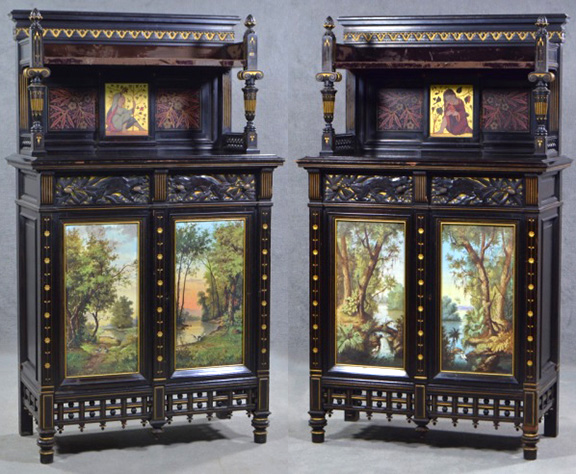
This pair of Herter Brothers servers was the high lot of the Farmer sale. The servers are constructed of dark-stained rosewood, with maple as the secondary wood. There is a molded cornice, with a galleried shelf above an open cupboard and serving surface. The base consists of two drawers over a storage area enclosed by two doors. The skirt is a grillwork pattern, and the feet are turned. The servers are elaborately decorated, with virtually every area of carving displaying applied gilt. The top shelf is lined with velvet and is supported by elaborately turned urn-form columns, capped with Ionic column scrolls finished with acorn finials. The open cupboard backboard features a framed center painting on gilt metal foil, flanked by painted panels in a leaf and twig design. The lower cabinet drawers are deeply carved, and the door panels feature hand-painted woodland scenes on porcelain. One of the scenes is signed “Menard,” perhaps Gladys Menard, a turn-of-the-19th-/20th-century porcelain artist. There was intense bidding for the servers, which ultimately sold for $135,700 (est. $60,000/100,000). The winning bidder was Ken Farmer, bidding in the room on the phone with his client.
One interesting group of lots consisted of four mid-20th-century leather-seated barber chairs by Koken Barbers’ Supply Co., St. Louis, Missouri. All of the chairs were in working order and displayed engraved and punched decoration to the headrests and footrests. Prices for the chairs ranged from $200.60 to $265.50, approximately half of their estimates.
 Among furniture lots of note was a large, elaborately carved two-tiered oak Renaissance Revival sideboard/server from the late 19th century. The piece featured large winged lion figures supporting the upper shelf, with full-width beveled mirrors as the backboard of each tier. It sold for $2006, nearly twice its estimate.
Among furniture lots of note was a large, elaborately carved two-tiered oak Renaissance Revival sideboard/server from the late 19th century. The piece featured large winged lion figures supporting the upper shelf, with full-width beveled mirrors as the backboard of each tier. It sold for $2006, nearly twice its estimate.
Twentieth-century reproduction furniture also did well. A set of six Chippendale-style dining chairs adapted by Kittinger from Colonial Williamsburg examples brought $1888, more than twice the estimate. And a mahogany two-piece flat wall cupboard, from the same maker, also Williamsburg-inspired, sold for $885, solidly within estimate.
For additional information, contact Farmer Auctions at (540) 384-0100 or visit the website (www.farmer-auctions.com).
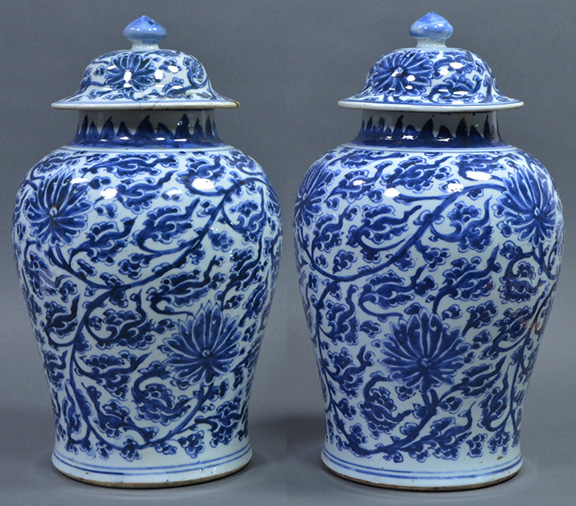
Here is a pair of large covered blue and white Chinese vases. The catalog states that they are likely from the Kangxi period (1662-1722) of the Qing Dynasty (1644-1911). The bodies are covered with scrolling lotus decoration in a deep blue. The vases measure 16" in overall height. One of the finials has been repaired. The pair sold to an Internet buyer for $4720 (est. $2000/3000).
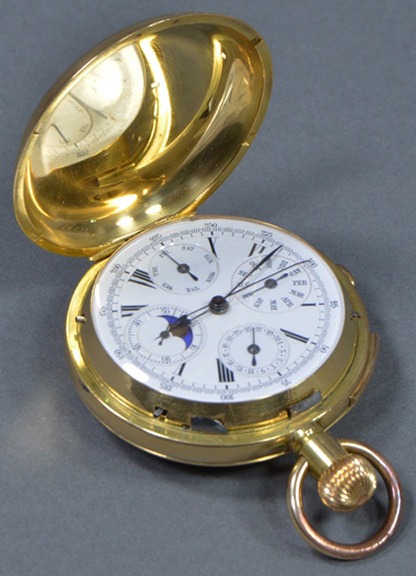
The gold hunter’s case pocket watch is marked 18k. The face is marked with Roman numerals and features four small dials to indicate month, day of the week, date, and a combination moon phase and second hand. The large sweep hand appears to be a stopwatch, as the outer ring of the dial is divided into 360 increments. The watch sold to an Internet buyer for $4425 (est. $1800/2600).
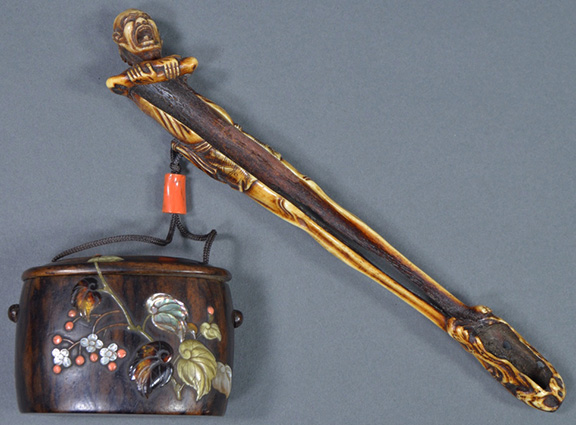
As far as antique netsuke are concerned, this is a large example. The 8¼" long figure is that of an elongated, gaunt male with folded arms and a pained expression on his face. The wooden inro is connected with a replaced cord and is decorated with applied floral elements fashioned from pink coral, mother-of-pearl, ivory, and carved hardstone. The lid displays a bird figure. This netsuke sold for $3245 (est. $350/500).
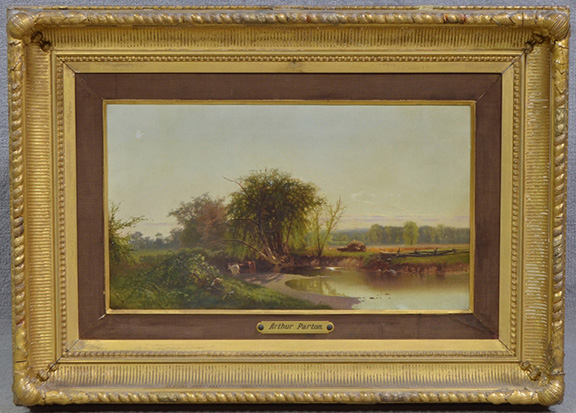
This pastoral scene is by Arthur Parton (1842-1914). The oil on canvas depicts cattle along a stream, with meadows and a hay cart in the background. The painting measures 10½" x 18½" (sight size), and it sold to an Internet buyer for $5015 (est. $1000/2000).
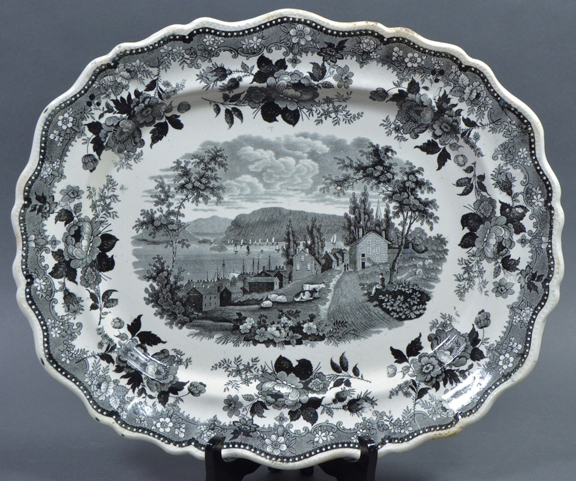
The black-and-white transferware platter measures 17½" x 14½" and displays a central image identified as “Newburgh” (New York). The Hudson River scene depicts a pastoral setting overlooking a riverside village, with ships in the distance as well as several moored on the near shore. The rim is scalloped, and the border decoration is a band of various floral arrangements. The piece is also marked “Jackson’s Warranted.” The Jackson pottery in Staffordshire, England operated between 1831 and 1835. This design is from its “American Scenery” series. The platter sold to a telephone bidder for $265.50 (est. $200/300).
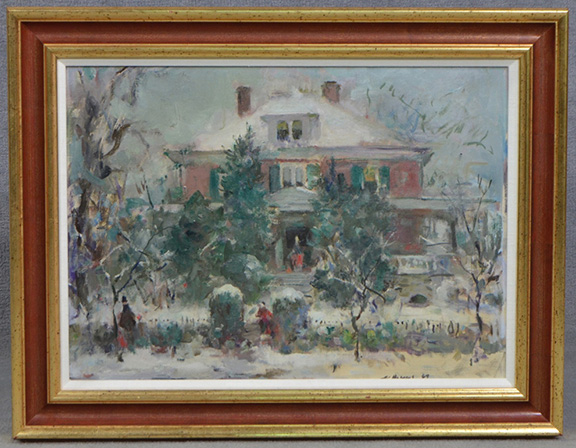
Walter Biggs (1886-1968) is a favorite among Virginia fine art collectors. Biggs was born outside of Salem, Virginia, and spent much of his active artistic life as an illustrator in New York City. This painting of the Denit house was commissioned by Salem resident Virginia Denit. It is signed “Walter Biggs ’64.” The oil on board shows the residence with a blanket of snow and figures at the house and moving along the sidewalk. The painting measures 16½" x 23½" (sight size). It sold for $10,030 (est. $5000/8000).
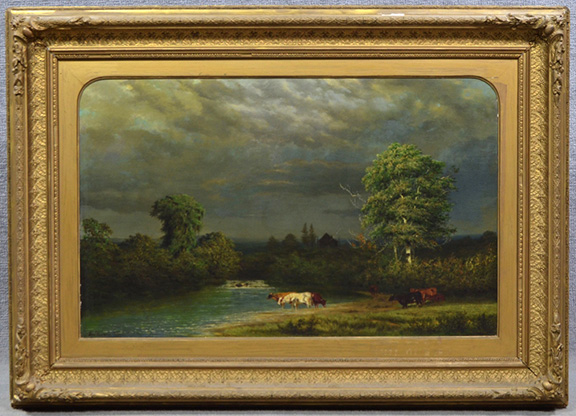
This oil on canvas by Alexander Wust (1837-1876) was the catalog cover art for the Farmer sale. The landscape scene depicts cattle at a stream with a dark and threatening sky. A cottage is silhouetted in the distance. The painting is signed, lower left, and measures 20" x 32" (sight size). It sold to an Internet buyer for $4425 (est. $800/1200).
Originally published in the June 2017 issue of Maine Antique Digest. © 2017 Maine Antique Digest







